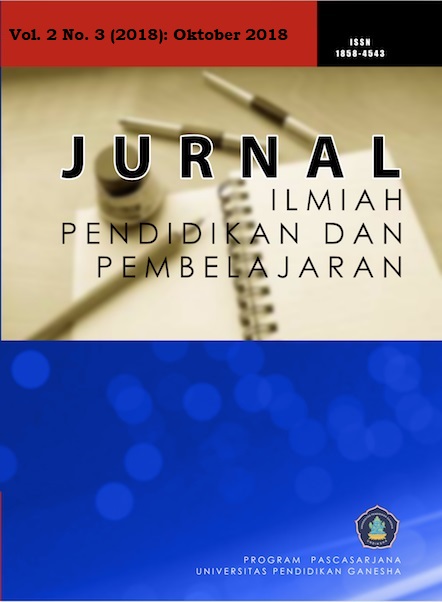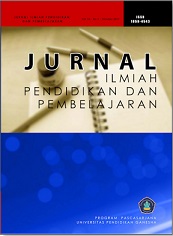PENGARUH MODEL PEMBELAJARAN LEARNING CYCLE 5E BERBANTUAN MEDIA LINGKUNGAN TERHADAP KOMPETENSI PENGETAHUAN IPA KELAS IV
DOI:
https://doi.org/10.23887/jipp.v2i3.16237Abstract
The aim of this research is to determine the significant differences of knowledge competence of science group of students which is taught by learning model of learning cycle 5E that is supported by environmental media compared with group of students that is taught by conventional learning in fourth grade students of SD Gugus Letkol Wisnu, North Denpasar District, in academic year 2017/2018. The design of this research is a quasi-experimental research with nonequivalent control group design. The population of this research is all the fourth grade students in SD Gugus Letkol Wisnu Sub District of North Denpasar, which is total 332 students that spread in 9 classes. The sample determination was done by random sampling technique. The sample in this research is the students of grade IV A SDN 1 Peguyangan with 43 students as experiment group and fourth grade students of SDN 12 Peguyangan with 41 students as control group. The data were collected by using the test method in the form of a standard multiple-choice objective test. The data obtained were analyzed using the t-test. Based on the results of data analysis obtained thitung = 4,453 while at the level of significance 5% and dk = 82 obtained ttable value = 1,989 so thitung = 4,453 > ttable = 1,989. Based on the test criteria, Ho is rejected. The average score of science knowledge competence in the group that was taught by the Learning Cycle 5E model with the help of environmental media was 81,53, while in the group taught by conventional learning was 72,82. Based on the result, it can be concluded that there is influence of Learning Cycle 5E model with the help of environmental media on science knowledge competence of fourth grade students of SD Gugus Letkol Wisnu Sub-district of North Denpasar in academic year 2017/2018 Keywords : Learning Cycle 5E, environmental, knowledge competence of scienceReferences
Darmadi, Hamid. 2013. Metode Penelitian Pendidikan. Bandung: Alfabeta.
Hamalik, Oemar. 2013.Kurikulum dan Pembelajaran.Jakarta:Bumi Aksara.
Jakni. 2016. Metodologi Penelitian Eksperimen Bidang Pendidikan. Bandung:Alfabeta.
Kemendikbud. 2014. Permendikbud Nomor 57 Tahun 2014. Jakarta: Kementerian Pendidikan dan Kebudayaan.
Kemendikbud. 2014. Permendikbud Nomor 103 Tahun 2014. Jakarta: Kementerian Pendidikan dan Kebudayaan.
Kosasih. 2014. Strategi Belajar dan Pembelajaran.Bandung : Yrama Widya.
Ngalimun. 2017. Strategi dan Model Pembelajaran. Yogyakarta: Aswaja Pressindo.
Rahayuningsih, Rina and Masykuri, M. and Utami, Budi (2012) Penerapan Siklus Belajar 5E (Learning Cycle 5E) Disertai Peta Konsep Untuk Meningkatkan Kualitas Proses Dan Hasil Belajar Kimia Pada Materi Kelarutan Dan Hasil Kali Kelarutan Kelas XI IPA SMA Negeri 1 Kartasura Tahun Pelajaran 2011/2012. Jurnal Pendidikan Kimia (JPK), Volume 1, No , Halaman 51-58.
Sa’diah, Halimatus dkk. 2013. Remediasi Kesulitan Belajar Siswa Kelas XII IPA MAN 1 Pontianak Pada Materi Dinamika Rotasi Menggunakan Model Learning Cycle 5E. Jurnal Pendidikan dan Pembelajaran, Volume 2, Nomor 6.
Shoimin, Aris. 2014. 68 Model Pembelajaran Inovatif dalam Kurikulum 2013. Yogyakarta:AR-Ruzz Media.
Sayuti,Irda dkk. 2012. Penerapan Model Pembelajaran Learning Cycle 5e Untuk Meningkatkan Sikap Ilmiah Dan Hasil Belajar Biologi Siswa Kelas XI IPA 4 SMA Negeri 5 Pekanbaru. Jurnal Pendidikan, Volume 3, Nomor 1.
Susanto, Ahmad. 2013. Teori Belajar dan Pembelajaran di Sekolah Dasar. Jakarta:Kencana.
Wisudawati, Asih Widi dan Eka Sulistyowati.2015.Metodologi Pembelajaran IPA. Jakarta: Bumi Aksara.
Widya Pratiwi, Nurfitria. 2014. Penerapan Model Pembelajaran Learning Cycle 5E pada Materi Fluida Statis Siswa Kelas X SMA. Inovasi Pendidikan Fisika, Volume 3, Nomor 2.
Downloads
Published
How to Cite
Issue
Section
License
Authors who publish with the Jurnal Ilmiah Pendidikan dan Pembelajaran (JIPP) agree to the following terms:
- Authors retain copyright and grant the journal the right of first publication with the work simultaneously licensed under a Creative Commons Attribution License (CC BY-SA 4.0) that allows others to share the work with an acknowledgment of the work's authorship and initial publication in this journal.
- Authors are able to enter into separate, additional contractual arrangements for the non-exclusive distribution of the journal's published version of the work (e.g., post it to an institutional repository or publish it in a book), with an acknowledgment of its initial publication in this journal.
- Authors are permitted and encouraged to post their work online (e.g., in institutional repositories or on their website) prior to and during the submission process, as it can lead to productive exchanges, as well as earlier and greater citation of published work. (See The Effect of Open Access)










